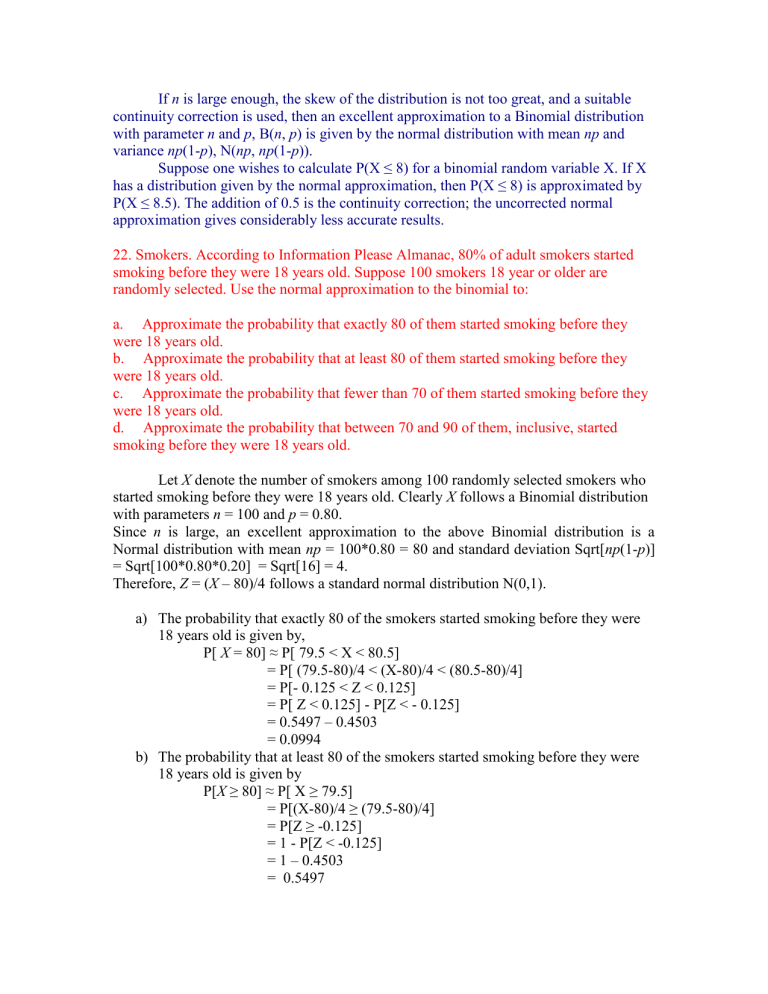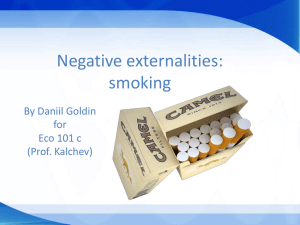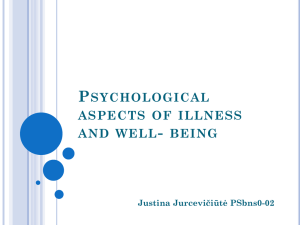If n is large enough, the skew of the distribution is not

If n is large enough, the skew of the distribution is not too great, and a suitable continuity correction is used, then an excellent approximation to a Binomial distribution with parameter n and p , B( n , p ) is given by the normal distribution with mean np and variance np (1p ), N( np , np (1p )).
Suppose one wishes to calculate P(X ≤ 8) for a binomial random variable X. If X has a distribution given by the normal approximation, then P(X ≤ 8) is approximated by
P(X ≤ 8.5). The addition of 0.5 is the continuity correction; the uncorrected normal approximation gives considerably less accurate results.
22. Smokers. According to Information Please Almanac, 80% of adult smokers started smoking before they were 18 years old. Suppose 100 smokers 18 year or older are randomly selected. Use the normal approximation to the binomial to: a. Approximate the probability that exactly 80 of them started smoking before they were 18 years old. b. Approximate the probability that at least 80 of them started smoking before they were 18 years old. c. Approximate the probability that fewer than 70 of them started smoking before they were 18 years old. d. Approximate the probability that between 70 and 90 of them, inclusive, started smoking before they were 18 years old.
Let X denote the number of smokers among 100 randomly selected smokers who started smoking before they were 18 years old. Clearly X follows a Binomial distribution with parameters n = 100 and p = 0.80.
Since n is large, an excellent approximation to the above Binomial distribution is a
Normal distribution with mean np = 100*0.80 = 80 and standard deviation Sqrt[ np (1p )]
= Sqrt[100*0.80*0.20] = Sqrt[16] = 4.
Therefore, Z = ( X – 80)/4 follows a standard normal distribution N(0,1). a) The probability that exactly 80 of the smokers started smoking before they were
18 years old is given by,
P[ X = 80] ≈ P[ 79.5 < X < 80.5]
= P[ (79.5-80)/4 < (X-80)/4 < (80.5-80)/4]
= P[- 0.125 < Z < 0.125]
= P[ Z < 0.125] - P[Z < - 0.125]
= 0.5497 – 0.4503
= 0.0994 b) The probability that at least 80 of the smokers started smoking before they were
18 years old is given by
P[ X ≥ 80] ≈ P[ X ≥ 79.5]
= P[(X-80)/4 ≥ (79.5-80)/4]
= P[Z ≥ -0.125]
= 1 - P[Z < -0.125]
= 1 – 0.4503
= 0.5497
c) The probability that fewer than 70 of the smokers started smoking before they were 18 years old is given by,
P[ X < 70] ≈ P[ X < 70.5]
= P[(X-80)/4 < (70.5-80)/4]
= P[Z < -2.375]
= 0.0088 d) The probability that between 70 and 90 of the smokers, inclusive, started smoking before they were 18 years old is given by,
P[70 ≤ X ≤ 90] ≈ P[ 69.5 ≤ X ≤ 90.5]
= P[ (69.5-80)/4 ≤ (X-80)/4 ≤ (90.5-80)/4]
= P[- 2.625 ≤ Z ≤ 2.625]
= P[ Z ≤ 2.625] - P[Z ≤ - 2.625]
= 0.9957 – 0.0043
= 0.9914
28.Females living at home. According to the Current Population Survey, 46% of females between the ages of 18 and 24 years lived at home in 2003. (Unmarried college students living in a dorm are counted as living at home). Suppose that a survey is administered at a community college to 200 randomly selected female students between the ages of 18 and
24 years and that 110 of them respond that they live at home.
A. Approximate the probability that such a survey will result in at least 110 of the respondents living at home under the assumption that the true percentage is 46%.
B. Does the result from part (A) contradict the results of the Current Population
Survey? Explain.
Let X denotes the number of respondents among 200 randomly selected female students between the ages of 18 and 24 years who respond that they live at home. Clearly X follows a Binomial distribution with parameters n = 200 and p = 0.46.
Since n is large, an excellent approximation to the above Binomial distribution is a
Normal distribution with mean np = 200*0.46 = 92 and standard deviation Sqrt[ np (1p )]
= Sqrt[200*0.46*0.54] = Sqrt[49.68] = 7.0484.
Therefore, Z = ( X – 92)/√49.68 follows a standard normal distribution N(0,1).
A) Now, the probability the survey will result in at least 110 of the respondents living at home under the assumption that the true percentage is 46% is
P[ X ≥ 110] ≈ P[ X ≥ 109.5]
= P[(X-92)/√49.68 ≥ (109.5-92)/√49.68]
= P[Z ≥ 2.483]
= 1 - P[Z < 2.483]
= 1 – 0.9935
= 0.0065
B) Since the probability that at least 110 of the respondents living at home is negligible, the result from part (A) contradicts the results of the Current Population Survey.







